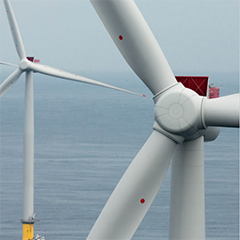While performing service and maintenance on wind energy plants, employees routinely work at great heights. Fall protection is therefore a requirement for them. They use climbing protection equipment when climbing the towers. When it comes to work safety, leading manufacturers are increasingly involving users in the development of new solutions. Collaboration between Siemens Gamesa, the manufacturer SKYLOTEC, and the supplier ICM Safety shows how this works successfully. The ’Claw’ cable runner for steel ropes is a solution that simplifies use and reduces the risk of accident.
With around 27,000 employees on five continents, Siemens Gamesa is one of the leading providers in the renewable energy industry. The company provides service and maintenance for 23,000 turbines around the world. They monitor more than 3,000 onshore and offshore facilities in Great Britain and Ireland alone. Fall protection is required for employees while they perform service and maintenance work on wind power systems.
This does not just apply to when they are working high up, on the turbine. In many cases, Siemens Gamesa employees reach the turbine by means of a climbing protection system that is installed within the tower. This consists of a rigid anchor line, such as a steel rope or rail and a guided type fall arrester, the climbing protection runner. It is worn on the body as part of Personal Protective Equipment (PPE) against falls and attached to the harness when climbing. When the runner is attached to the rigid anchor line, users can climb safely up and down. It also makes it easy for them to carry work materials or tools with them. In the event of a fall, a brake is triggered on the runner, preventing the user from a long fall.
Siemens Gamesa employees use climbing protection runners that they attach to a fixed steel rope. Equipment made by the Danish supplier ICM Safety, which sells its own vertical fall protection system, is installed within Siemens wind turbine towers in Great Britain. In 2010, the European Commission decided that EN 353-1:2002, according to which the guided type fall arresters including a rigid anchor line were certified, was no longer consistent with the PPE directive. That decision had consequences for manufacturers and users. This is because the installed climbing protection equipment no longer corresponded with the latest state of the art.


























